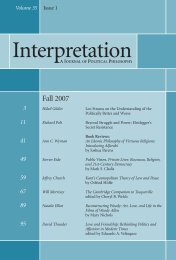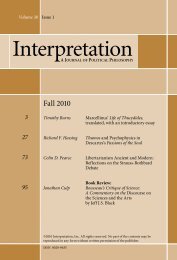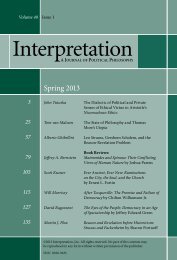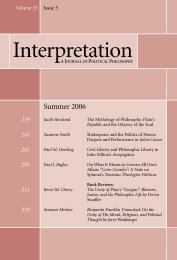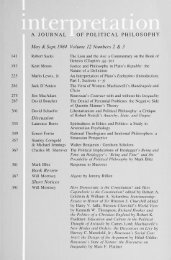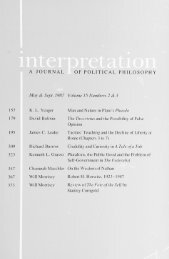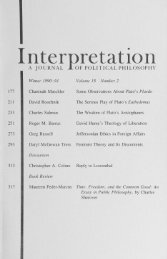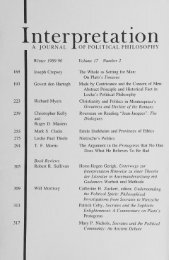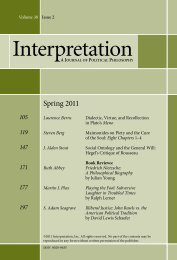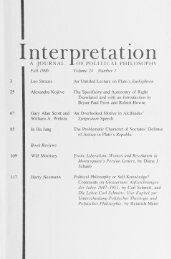Spring 2010 - Interpretation
Spring 2010 - Interpretation
Spring 2010 - Interpretation
You also want an ePaper? Increase the reach of your titles
YUMPU automatically turns print PDFs into web optimized ePapers that Google loves.
3 1 8 I n t e r p r e t a t i o n<br />
repeated qualifications (“it is declared,” “it seems”), Burger leads the reader<br />
into an increasingly dense thicket of uncertainty and perplexities. At the<br />
same time, however, she offers light to help illuminate the way. One such<br />
illumination is the recurring bifurcatory or dyadic structure she notices that<br />
runs throughout, which guides and informs Aristotle‘s dialectical examination.<br />
Perhaps the two most prominent examples of this, which also serve to<br />
divide the entire work itself into two parts, are the division between virtue<br />
of character and virtue of thought (books 2-6), and the division of rationality<br />
into practical and theoretical (books 6-10). Thus, while Aristotle declares<br />
at the beginning of book 2 that virtue is two—of character (ethical) and of<br />
thought (intellectual)—he concludes in book 6 that it is one: character and<br />
thought (desiring mind or intellectual desire). And, though immediately<br />
upon uniting reason and desire and declaring virtue to be one, he divides<br />
thought into two—practical versus theoretical—concerned with different<br />
praxeis and energeiai, his provocative linking of sophia and phronesis in book<br />
6 and knowledge and action at the end of book 10 challenge one to consider<br />
what the truly beautiful action, the best activity for human being, might be.<br />
If we examine these two dyads, we find two common threads,<br />
and in these two, perhaps the deepest dyad of the work. One common thread<br />
is phronesis. In books 2-6, ethical virtue is pursued and examined in opposition<br />
to, or at least independence from phronesis (intellectual virtue). In book<br />
6, when that opposition appears to have been resolved, and the two have been<br />
brought together, with (ethical) virtue supplying the end and phronesis determining<br />
the means (and the mean), a new dyad appears, as Burger points out<br />
(116-20). This time phronesis as the virtue or excellence of practical reason<br />
stands in opposition to sophia as the virtue or excellence of theoretical reason.<br />
Theory stands in contradistinction to action. There is, however, a second common<br />
thread in these two dyads and that is the beautiful (to kalon). For both<br />
ethical virtue and sophia have an eros for and look to the beautiful. Each half<br />
of the Ethics, therefore, posits a division, perhaps even opposition, between<br />
phronesis and eros for the beautiful. “Eros for the beautiful,” however, Burger<br />
reminds us, is Socrates’ characterization of philosophy as he understands it<br />
and practices it, and phronesis is the name Socrates employs when he speaks<br />
of the knowledge that is (or accompanies) virtue, and the human knowledge<br />
of ignorance, which is the knowledge he claims to have. Thus, Burger suggests,<br />
at the heart of Aristotle’s Ethics lies the question of the relation between<br />
Socratic phronesis (human wisdom) and Socratic philosophy (112).



